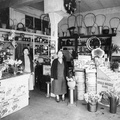I have written extensively on the Franciscan Friars and Sisters of the Atonement’s Japanese Catholic Mission connection with the Japanese Canadians in Steveston and Vancouver’s Powell Street Japantown. Of course, they were the ones responsible for bringing the mostly Catholic Japanese Canadians to the first internment site of Greenwood in 1942.
The United Church groups were to be sent to internment camps in Kaslo, Tashme, New Denver, and Slocan area, however, the government decided to send the overflowing United Church members to various ‘camps’.
Esumatsu Nakatani, a Christian, who had lived in Grand Forks, a neighbouring town of Greenwood, prior to 1942 invited some 300 Japanese Canadians to the self-supporting camp. As a result, Rev. Ogura was appointed to Grand Forks, and he was to also serve Greenwood, Midway, and Christina Lake.
Madeleine Bock, who was a missionary in Victoria’s Oriental House, had experience working with the Asian immigrants. Her favourite activity was organizing C.G.I.T. (Christian Girls in Training). When war broke out, Ms. Bock was assigned to Greenwood on June 27th, 1942, two months after the Franciscan Sisters’ arrival in Greenwood.

Initially, Ms. Bock started slowly trying to seek out United Church families. She began summer school with only a few members. Eventually, it increased to over a hundred children. Therefore, Ms. Bock asked for Grace Namba to teach choir. Local children integrated with the Japanese Canadian students. Miss Namba started a kindergarten class, and hoped to expand to primary grades. However, Ms. Bock and Miss Namba asked the B.C. Security Commission and the Greenwood Board of Education to enroll Japanese Canadian students in the local public school, permission was granted. By 1954, all students attended Greenwood Elementary-High School when Sacred Heart School closed.
Fortunately, Greenwood didn’t operate like other internment camps in B.C. because Japanese Canadians were able to integrate into the community. After the war, many of the businesses were Nikkei owned or operated, such as Windsor (Omae Bros.) and Mook’s Cafe (Mukai), Higashi Plumbing, Imai Shoe Repair and Electric, Nakagawa Dry Cleaners, Tanizawa Greenwood Bakery, Nakamura Shoten, Koto Watanabe’s Cherry Shoppe hair salon, Tasaka Barber and Pool Hall, Hiko’s Radio, and Kuroda’s Watch Repair shops. There were Japanese Canadian carpenters, doctors, teachers, and nurses as well. It was almost like Japantown. The church groups have played a pivotal part in the regular daily lives of the Japanese Canadians. It is a fitting tribute to honour the ones who did right instead of ones who did wrong.
Timeline: Excerpts were taken from the book, A History of the Japanese Congregations in The United Church of Canada: 1892-1959 translated by the Japanese Canadian Christian Churches Historical Project with general editor Roland M. Kawano.
• 1870’s: Canadian and American missionaries were in Japan to ordain Japanese to send to North America.
• 1896: Goro Kaburagi from the U.S. was sent to Vancouver to become the founder of the first Japanese Canadian Methodist Church. He encouraged young people to become evangelists. As a result, there were ministers in many ‘Japanese’ settlements spread throughout B.C.
• 1897-1901, Ukichi Oyama was a minister in Steveston and in 1902-03, he was in Cumberland. Rev. Oyama’s connection to Greenwood is that he was the father of Ruth Hamaguchi. Paul and Ruth Hamaguchi were interned in Greenwood.
• 1925: June 10th, Methodists, Presbyterians and the Congregationalists combined to form the United Church of Canada.
• 1942: When the forced removal of Japanese Canadians began, the United Church was assigned to Kaslo, Tashme, New Denver and Lemon Creek. Greenwood was to receive mostly Roman Catholics, however, sprinkling of United Church members were sent to Greenwood.
• Rev. Ogura and Mrs. Ogura were sent to Grand Forks, but they were in charge of Greenwood as well.
• Madeleine Bock, Women’s Missionary Society of Victoria, was sent to Greenwood on June 27th to start Sunday school. At the beginning there were only a few students, but later there were more than one hundred students. Therefore, Ms. Bock asked WMS to send Miss Grace Namba to assist in the program. She came in time for summer school and later opened a kindergarten.
• Ms. Bock and Miss Namba organized Mission Band, Explorer, C.G.I.T. for girls and Rangers for boys. A piano was sent by WMS, and a choir was set up. They asked the BCSC and the Greenwood Board of Education to enroll Japanese Canadian students in the local public school. Permission was granted.

• In time, the local parents sent their children to integrate into the Japanese Canadian kindergarten and other activities.
• In nearby village of Midway, they were asked to start a kindergarten there as well. By then, Ms. Bock took a leave. Miss Namba became deaconess and Miss Lediard and Miss Roson were appointed.
• 1951: Rev. Ogura moved to Manitoba. Miss Namba continued on extending all the way to Grand Forks and Cascade.
• 1955: Miss Namba took a leave and Ms. Bock returned to take over her work.
• As Japanese Canadians at Sunday school decreased by half, the mission ended and left it up to the local churches.
• The original United Church building was torn down after when the new St. Columba Church was built in 1960.
• January 1st, 2017, St. Columba United Church closed.
© 2021 Chuck Tasaka





